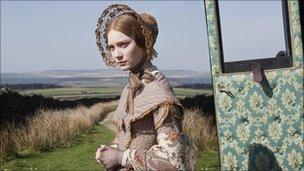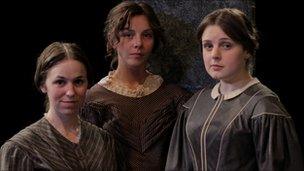Bronte sisters: Why their stories still enthral
- Published
- comments

Australian-born actress Mia Wasikowska stars in the new film version of Jane Eyre
This week, major film adaptations of Emily Bronte's Wuthering Heights and Charlotte Bronte's Jane Eyre will be in the spotlight, along with a play about the lives of the literary sisters.
After 160 years, the power of the Bronte sisters' ferocious imaginations has not dimmed at all.
On Tuesday, the world premiere of a screen adaptation of Wuthering Heights takes place at the Venice Film Festival. Its director is Andrea Arnold, who won a Bafta last year for best British film for the critically acclaimed Fish Tank.
Skins actress Kaya Scodelario plays the headstrong Cathy, while the part of Heathcliff is taken by James Howson, from Leeds, in his first film role.
It is believed to be the first time the famously passionate Heathcliff, described in the book as a "dark-skinned gypsy", has been played by a black actor.
On Friday, Jane Eyre opens in UK cinemas, with the lead role filled by Mia Wasikowska.
The Australian actress - who played Alice in Tim Burton's Alice in Wonderland last year - is joined on screen by Michael Fassbender, Dame Judi Dench and Jamie Bell.
.jpg)
Director Andrea Arnold chose James Howson to play Heathcliff after open casting sessions
On the same night, a play about Emily, Charlotte and their younger sister Anne - author of Agnes Grey and The Tenant of Wildfell Hall - opens in Halifax before going on a national tour.
Scripted by journalist and author Blake Morrison for the Northern Broadsides theatre company, We Are Three Sisters links the siblings' story with Chekhov's Three Sisters, which some believe was based on the Brontes.
These dramas join a lengthy list of artistic works that have been inspired by the sisters and their writing. Is there a reason why all three have come along now?
Jane Eyre director Cary Fukunaga suggests that current audiences may be drawn to gothic tales.
"People like darker types of stories, which is maybe why there's less Jane Austen films being made," he says.
"But also I think that it's a story that's going to be retold again and again, mainly because of the strength of the characters and the depiction of the characters."

From left, Catherine Kinsella, Sophia Di Martino and Rebecca Hutchinson star in We Are Three Sisters
For 21-year-old Wasikowska, the sisters have clearly not aged much. They are "awesome" and "so bad-ass", she says.
Jane Eyre is a timeless story, she believes. "If you take away the period setting and the costumes, the core of it is a young girl who's trying to find love and connection in a very isolated and dislocated world," she says.
"Boy or girl, I think it's identifiable to anyone of any generation."
Blake Morrison, who first had the idea for his play 10 years ago, says the current collision of Bronte projects is little more than coincidence. The sisters' works, he believes, are "in permanent revival".
"The Brontes are just perennially, habitually, forever interesting," he says. "Like any classic authors, they just keep hovering there and haunting us."
For Morrison, the true story is as compelling as the novels.
The Brontes' mother died in 1821, leaving six children between the ages of one and seven. The eldest two, Maria and Elizabeth, died in quick succession in 1825, aged 10 and 11, after a typhus outbreak at their boarding school.
Charlotte, now the eldest surviving child, based the conditions at Lowood in Jane Eyre on their experiences at the inhospitable school.
With brother Branwell, the girls began to immerse themselves in an insular fantasy world of imaginary heroes and romances, writing down the stories in tiny script.
"The deaths of two of the siblings meant perhaps that these three, and Branwell, pulled the force back on each other intensely," Morrison says.
"They had a very tight atmosphere and story-telling became, from an early age, just an ordinary part of their lives.
"It was like a kind of apprenticeship as children, as writers making up imaginary worlds, and as young women that continued."
Their father, Patrick, was the first member of the family to be published, having lifted himself from an illiterate Irish family to attend Cambridge University and write several volumes of poetry.
"The Brontes grew up used to seeing their father's books on the shelves of the parsonage," says Andrew McCarthy, director of the Bronte Parsonage Museum in the family's former home in Haworth, West Yorkshire.
"And he was a tremendously liberal educator of his children. I think the way he educated his children really opened up the possibilities for them in terms of the creative life that they pursued from a very early age."
Graduating from childhood stories to novels, the sisters would work after Patrick had gone to bed, reading and talking over their plans and projects.
While doing so they would pace their parlour "like restless wild animals", as Charlotte's friend and biographer Elizabeth Gaskell put it.
Jane Eyre, Wuthering Heights and Agnes Grey were published, under the pseudonyms Currer, Ellis and Acton Bell, within several months of each other in 1847.
Emily died the following year, aged 30, while Anne died in 1849 aged 29. Charlotte was left to walk in the parlour alone.
She died in 1855, at the age of 35, having experienced literary acclaim but with little notion of the lasting impact her family would have.
- Published24 May 2011
- Published22 March 2011